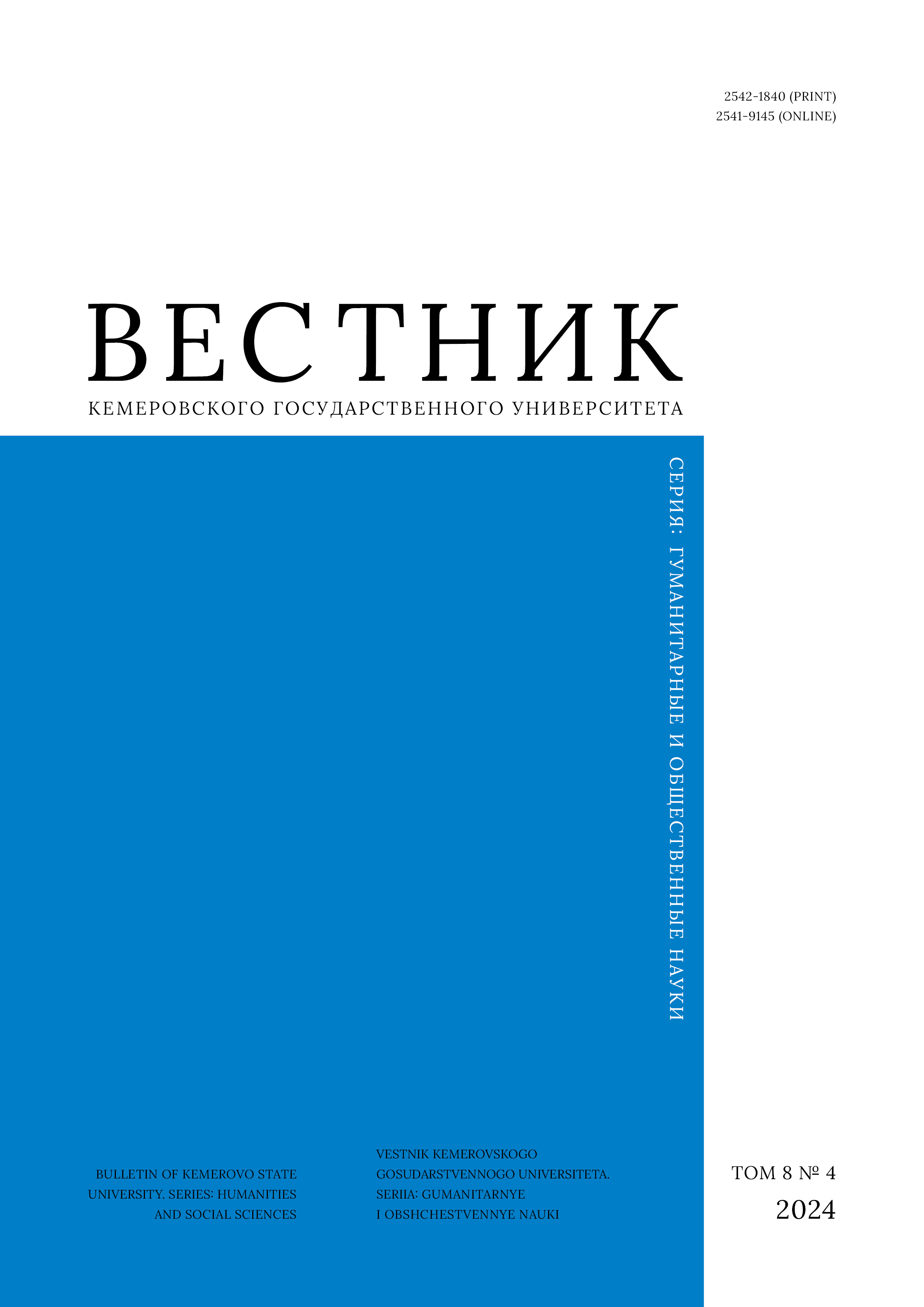Kemerovo, Russian Federation
Kemerovo, Russian Federation
Kemerovo, Russian Federation
Kemerovo, Russian Federation
The article describes the cognitive and verbal features of dialogic speech produced by teenage patients operated for congenital heart defect. Doctor-patient dialogues remain linguistically understudied when it comes to pediatric patients with a history of septal congenital heart defect that required cardiopulmonary bypass surgery. The research featured 27 depersonalized dialogues between a cardiologist and a teenage patient (13–15 y.o.) 6 or 7 days after heart surgery. The objective was to describe how questions and answers structured the dialogue between the patient and the cardiologist as the latter collected direct post-surgery anamnesis. The analysis relied on the methods of discourse, structural, and syntactic analyses, which made it possible to typologize the questions and responses. The question-answer interaction proved rapid, brief, and syntactically dependent. The cardiologist directed their patient’s speech activity by employing effective questioning and guiding tactics. Practically all lines were semantically, structurally, and communicatively interrelated. One-word responses and communication failures were probably associated with the teenage psychology and/or recovery status.
medical discourse, dialogic speech, question, response, patients with CHD, cognitive and verbal features
1. King A., Hoppe R. B. "Best practice" for patient-centered communication: A narrative review. Journal of Graduate Medical Education, 2013, 5(3): 385–393. https://doi.org/10.4300/jgme-d-13-00072.1
2. Ratna H. The importance of effective communication in healthcare practice. Harvard Public Health Review, 2019, 23. https://doi.org/10.54111/0001/W4
3. Power E. G. M. Considerations for effective communication of medical information. Pharmaceutical Medicine, 2023, 37(2): 97–101. https://doi.org/10.1007/s40290-023-00461-3 EDN: https://elibrary.ru/GDDYPP
4. Sharkiya S. H. Quality communication can improve patient-centred health outcomes among older patients: A rapid review. BMC Health Services Research, 2023, 23(1). https://doi.org/10.1186/s12913-023-09869-8 EDN: https://elibrary.ru/ZQELMM
5. Cappola A. R., Cohen K. S. Strategies to improve medical communication. JAMA, 2024, 331(1): 70–71. https://doi.org/10.1001/jama.2023.23430 EDN: https://elibrary.ru/ACSYLN
6. Taratukhin E. O., Kudinova M. A., Shnaider Ya. E., Shaydyuk O. Yu. The components of clinical interaction ethics. Russian Journal of Cardiology, 2022, 27(9): 118–123. (In Russ.) https://doi.org/10.15829/1560-4071-2022-5203 EDN: https://elibrary.ru/CGHSCD
7. Shvets Yu. Yu. The concept of patient and doctor dignity in the Russian Federation. Problems of Social Hygiene, Public Health and History of Medicine, 2022, 30(S): 1155–1161. (In Russ.) http://dx.doi.org/10.32687/0869-866X-2022-30-s1-1155-1161 EDN: https://elibrary.ru/GEQGWC
8. Oshkokova J. D., Antsiferova O. N. About the strategies of the doctor’s speech behavior. Current issues of modern medical and healthcare: Proc. VI Intern. Sci.-Prac. Conf., Ekaterinburg, 8–9 Apr 2021. Ekaterinburg: USMU, 2021, vol. 3, 295–299. (In Russ.) https://elibrary.ru/xpjkqy
9. Kameneva V. A., Morozova I. S. Psycholinguistic issues of medical communication. Vestnik NSU. Series: Linguistics and Intercultural Communication, 2023, 21(2): 75–88. (In Russ.) https://doi.org/10.25205/1818-7935-2023-21-2-75-88 EDN: https://elibrary.ru/DGIKIG
10. Skalkin V. L. Teaching dialogic speech: Based on the English language. Kyiv: Rad. shk., 1989, 156. (In Russ.)
11. Yakubinsky L. P. Dialogical speech. In: Yakubinsky L. P. Selected works: Language and its functioning. Moscow: Nauka, 1986, 17–58. (In Russ.)
12. Bim I. L. Theory and practice of teaching German in secondary school: Problems and prospects. Moscow: Prosveshchenie, 1988, 256. (In Russ.)
13. Blokh M. Ya., Polyakov S. M. Structure of dialogical speech. Moscow: Prometei, 1992, 153. (In Russ.)
14. Krems I. A. Communication problems in medicine. Relevant issues of medicine: Proc. II Intern. Sci.-Prac. Conf., Penza, 20 Dec 2020. Penza: Nauka i Prosveshchenie (IP Guliaev G. Iu.), 2020, 8–10. (In Russ.) https://elibrary.ru/kaegna
15. Shaposhnik I. I., Bogdanov D. V., Genkel V. V., Kolyadich M. I. Experience in teaching deontology to students by managing patients with cardiovascular diseases. Russian Journal of Cardiology, 2020, 25(9): 20–24. (In Russ.) https://doi.org/10.15829/1560-4071-2020-3922 EDN: https://elibrary.ru/NJFMQJ
16. Walton D. N., Krabbe E. C. W. Commitment in dialogue: Basic concepts of interpersonal reasoning. Albany: State University of New York Press, 1995, 236.
17. Posner R. Types of dialogue: The functions of commenting. Discourse Processes, 1980, 3(4): 381–398. https://doi.org/10.1080/01638538009544499
18. Goykhman O. Ya., Nadeina T. M. Fundamentals of speech communication. Moscow: INFRA-M, 1997, 272. (In Russ.) https://elibrary.ru/raolyd
19. Borodulina M. K., Minina N. M. Fundamentals of teaching foreign languages at a linguistic university. Moscow: Vyssh. shk., 1968, 118. (In Russ.)
20. Xalmuratova M. T. The importance of the dissolution of the patient in the diagnostic process. Ekonomika i sotsium, 2018, (4): 677–680. (In Russ.) https://elibrary.ru/uufbke
21. Tetenev F. F., Bodrova T. N. Interviewing patients in the clinic for internal medicine: Materials for clinical lectures. Tomsk: SibSMU, 2010, 239. (In Russ.) https://elibrary.ru/qlyklr
22. Kaldarbekov S. N., Mamyrbekova S. A., Tokbay A. B. Communication barriers and methods of overcoming them in a medical organization. Vestnik nauki i tvorchestva, 2022, (5): 40–45. (In Russ.) https://elibrary.ru/xsawxp
23. Kameneva V. A., Rumyantseva A. A. Communicative failures. Cognitive impairments as one of the communication barriers in communication between a pediatric cardiologist and a patient. Science and education: Problems and prospects: Proc. XXV Intern. Sci.-Prac. Conf., Biysk, 28 Apr 2023. Biysk: ASHPU, 2023, 140–143. (In Russ.) https://elibrary.ru/isnkgx
24. Davidov D. R., Moskvicheva A. S., Shubina L. B., Shikina I. B. Issues related to doctor-patient communication. Social Aspects of Population Health, 2023, 69(3). (In Russ.) https://doi.org/10.21045/2071-5021-2023-69-3-2 EDN: https://elibrary.ru/AKNTVR
25. Rumyantseva A. A., Kameneva V. A. Comparative analysis of receptive and expressive language indicators in primary schoolchildren with septal congenital heart defects. Complex Issues of Cardiovascular Diseases, 2023, 12(S4): 6–12. (In Russ.) https://doi.org/10.17802/2306-1278-2023-12-4S-6-12 EDN: https://elibrary.ru/SDOTGI






















